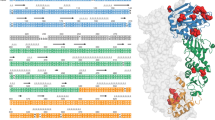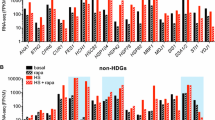Abstract
The Heat Shock Protein 70s (Hsp70s) are an essential family of proteins involved in folding of new proteins and triaging of damaged proteins for proteasomal-mediated degradation. They are highly conserved in all organisms, with each organism possessing multiple highly similar Hsp70 variants (isoforms). These isoforms have been previously thought to be identical in function differing only in their spatio-temporal expression pattern. The model organism Saccharomyces cerevisiae (baker’s yeast) expresses four Hsp70 isoforms Ssa1, 2, 3 and 4. Here, we review recent findings that suggest that despite their similarity, Ssa isoforms may have unique cellular functions.



Similar content being viewed by others
References
Becker J, Walter W, Yan W, Craig EA (1996) Functional interaction of cytosolic hsp70 and a DnaJ-related protein, Ydj1p, in protein translocation in vivo. Mol Cell Biol 16(8):4378–4386
Boorstein WR, Craig EA (1990) Structure and regulation of the SSA4 HSP70 gene of Saccharomyces cerevisiae. J Biol Chem. 265(31):18912–18921
Boorstein WR, Craig EA (1990) Transcriptional regulation of SSA3, an HSP70 gene from Saccharomyces cerevisiae. Mol Cell Biol 10(6):3262–3267
Boorstein WR, Ziegelhoffer T, Craig EA (1994) Molecular evolution of the HSP70 multigene family. J Mol Evo 38(1):1–17
Brehme M, Voisine C (2016) Model systems of protein-misfolding diseases reveal chaperone modifiers of proteotoxicity. Dis Model Mech 9(8):823–838
Brown CR, McCann JA, Chiang HL (2000) The heat shock protein Ssa2p is required for import of fructose-1, 6-bisphosphatase into Vid vesicles. J Cell Biol 150(1):65–76
Christiano R, Nagaraj N, Frohlich F, Walther TC (2014) Global proteome turnover analyses of the Yeasts S cerevisiae and S pombe. Cell Rep 9(5):1959–1965
Cloutier P, Coulombe B (2013) Regulation of molecular chaperones through post-translational modifications: decrypting the chaperone code. Biochim Biophys Acta 1829(5):443–454
Craig EA, Marszalek J (2017) How do J-proteins get Hsp70 to do so many different things? Trends Biochem Sci 42(5):355–368
Dunn DM, Woodford MR, Truman AW, Jensen SM, Schulman J, Caza T et al (2015) c-Abl mediated tyrosine phosphorylation of Aha1 activates its co-chaperone function in cancer cells. Cell Rep 12(6):1006–1018
Dushukyan N, Dunn DM, Sager RA, Woodford MR, Loiselle DR, Daneshvar M et al (2017) Phosphorylation and ubiquitination regulate protein phosphatase 5 activity and its prosurvival role in kidney cancer. Cell Rep 21(7):1883–1895
Gao BC, Biosca J, Craig EA, Greene LE, Eisenberg E (1991) Uncoating of coated vesicles by yeast hsp70 proteins. J Biol Chem 266(29):19565–19571
Gardner JM, Jaspersen SL (2014) Manipulating the yeast genome: deletion, mutation, and tagging by PCR. Methods Mol Biol 1205:45–78
Gowda NK, Kaimal JM, Masser AE, Kang W, Friedlander MR, Andreasson C (2016) Cytosolic splice isoform of Hsp70 nucleotide exchange factor Fes1 is required for the degradation of misfolded proteins in yeast. Mol Biol Cell 27(8):1210–1219
Guinan E, Jones GW (2009) Influence of Hsp70 chaperone machinery on yeast prion propagation. Protein Pept Lett 16(6):583–586
Gupta A, Puri A, Singh P, Sonam S, Pandey R, Sharma D (2018) The yeast stress inducible Ssa Hsp70 reduces alpha-synuclein toxicity by promoting its degradation through autophagy. PLoS Genet 14(10):e1007751
Hasin N, Cusack SA, Ali SS, Fitzpatrick DA, Jones GW (2014) Global transcript and phenotypic analysis of yeast cells expressing Ssa1, Ssa2, Ssa3 or Ssa4 as sole source of cytosolic Hsp70-Ssa chaperone activity. BMC Genomics 15:194
Huang D, Moffat J, Andrews B (2002) Dissection of a complex phenotype by functional genomics reveals roles for the yeast cyclin-dependent protein kinase Pho85 in stress adaptation and cell integrity. Mol Cell Biol 22(14):5076–5088
Hubscher V, Mudholkar K, Rospert S (2017) The yeast Hsp70 homolog Ssb: a chaperone for general de novo protein folding and a nanny for specific intrinsically disordered protein domains. Curr Genet 63(1):9–13
Jaiswal H, Conz C, Otto H, Wolfle T, Fitzke E, Mayer MP et al (2011) The chaperone network connected to human ribosome-associated complex. Mol Cell Biol 31(6):1160–1173
Jones GW, Masison DC (2003) Saccharomyces cerevisiae Hsp70 mutations affect [PSI+] prion propagation and cell growth differently and implicate Hsp40 and tetratricopeptide repeat cochaperones in impairment of [PSI+]. Genetics 163(2):495–506
Jones G, Song Y, Chung S, Masison DC (2004) Propagation of Saccharomyces cerevisiae [PSI+] prion is impaired by factors that regulate Hsp70 substrate binding. Mol Cell Biol 24(9):3928–3937
Jung G, Jones G, Wegrzyn RD, Masison DC (2000) A role for cytosolic hsp70 in yeast [PSI(+)] prion propagation and [PSI(+)] as a cellular stress. Genetics 156(2):559–570
Kabani M, Martineau CN (2008) Multiple hsp70 isoforms in the eukaryotic cytosol: mere redundancy or functional specificity? Curr Genomics 9(5):338–348
Kampinga HH, Craig EA (2011) The HSP70 chaperone machinery: J proteins as drivers of functional specificity. Nat Rev Mol Cell Biol 11(8):579–592
Kim YE, Hipp MS, Bracher A, Hayer-Hartl M, Hartl FU (2013) Molecular chaperone functions in protein folding and proteostasis. Ann Rev Biochem 82:323–355
Knighton LE, Delgado LE, Truman AW (2019) Novel insights into molecular chaperone regulation of ribonucleotide reductase. Curr Genet 65(2):477–482
Koike N, Hatano Y, Ushimaru T (2018) Heat shock transcriptional factor mediates mitochondrial unfolded protein response. Curr Genet 64(4):907–917
Kuzmin E, VanderSluis B, Wang W, Tan G, Deshpande R, Chen Y et al (2018) Systematic analysis of complex genetic interactions. Science 360(6386):pii:eaao1729. https://doi.org/10.1126/science.aao1729
Liu XD, Morano KA, Thiele DJ (1999) The yeast Hsp110 family member, Sse1, is an Hsp90 cochaperone. J Biol Chem 274(38):26654–26660
Loovers HM, Guinan E, Jones GW (2007) Importance of the Hsp70 ATPase domain in yeast prion propagation. Genetics 175(2):621–630
Matsumoto R, Akama K, Rakwal R, Iwahashi H (2005) The stress response against denatured proteins in the deletion of cytosolic chaperones SSA1/2 is different from heat-shock response in Saccharomyces cerevisiae. BMC Genomics 6:141
Matveenko AG, Barbitoff YA, Jay-Garcia LM, Chernoff YO, Zhouravleva GA (2018) Differential effects of chaperones on yeast prions: current view. Curr Genet 64(2):317–325
Mayer MP, Bukau B (2005) Hsp70 chaperones: cellular functions and molecular mechanism. Cell Mol Life Sci 62(6):670–684
Mayer MP (2018) Intra-molecular pathways of allosteric control in Hsp70s. Philos Trans R. Soc Lond B Biol Sci 373(1749) pii:20170183. https://doi.org/10.1098/rstb.2017.0183
Mollapour M, Neckers L (2012) Post-translational modifications of Hsp90 and their contributions to chaperone regulation. Biochim Biophys Acta 1823(3):648–655
Mollapour M, Tsutsumi S, Truman AW, Xu W, Vaughan CK, Beebe K et al (2011) Threonine 22 phosphorylation attenuates Hsp90 interaction with cochaperones and affects its chaperone activity. Mol Cell 41(6):672–681
Nillegoda NB, Wentink AS, Bukau B (2018) Protein disaggregation in multicellular organisms. Trends Biochem Sci 43(4):285–300
Nitika, Truman AW (2017) Cracking the chaperone code: cellular roles for Hsp70 phosphorylation. Trends Biochem Sci 42(12):932–935
Roberts BT, Moriyama H, Wickner RB (2004) [URE3] prion propagation is abolished by a mutation of the primary cytosolic Hsp70 of budding yeast. Yeast 21(2):107–117
Sager RA, Woodford MR, Neckers L, Mollapour M (2018) Detecting posttranslational modifications of Hsp90. Methods Mol Biol 1709:209–219
Sager RA, Woodford MR, Backe SJ, Makedon AM, Baker-Williams AJ, DiGregorio BT, et al. (2019) Post-translational Regulation of FNIP1 Creates a Rheostat for the Molecular Chaperone Hsp90. Cell Rep 26(5), 1344–56 e5.
Schwimmer C, Masison DC (2002) Antagonistic interactions between yeast [PSI(+)] and [URE3] prions and curing of [URE3] by Hsp70 protein chaperone Ssa1p but not by Ssa2p. Mol Cell Biol 22(11):3590–3598
Sharma D, Masison DC (2011) Single methyl group determines prion propagation and protein degradation activities of yeast heat shock protein (Hsp)-70 chaperones Ssa1p and Ssa2p. Proc Natl Acad Sci USA 108(33):13665–13670
Sluder IT, Nitika, Knighton LE, Truman AW (2018) The Hsp70 co-chaperone Ydj1/HDJ2 regulates ribonucleotide reductase activity. PLoS Genet. 14(11):e1007462
Truman AW, Millson SH, Nuttall JM, Mollapour M, Prodromou C, Piper PW (2007) In the yeast heat shock response, Hsf1-directed induction of Hsp90 facilitates the activation of the Slt2 (Mpk1) mitogen-activated protein kinase required for cell integrity. Eukaryot Cell 6(4):744–752
Truman AW, Kristjansdottir K, Wolfgeher D, Hasin N, Polier S, Zhang H et al (2012) CDK-dependent Hsp70 Phosphorylation controls G1 cyclin abundance and cell-cycle progression. Cell 151(6):1308–1318
Truman AW, Kristjansdottir K, Wolfgeher D, Ricco N, Mayampurath A, Volchenboum SL et al (2015) Quantitative proteomics of the yeast Hsp70/Hsp90 interactomes during DNA damage reveal chaperone-dependent regulation of ribonucleotide reductase. J Proteomics 112:285–300
Truman AW, Kristjansdottir K, Wolfgeher D, Ricco N, Mayampurath A, Volchenboum SL et al (2015) The quantitative changes in the yeast Hsp70 and Hsp90 interactomes upon DNA damage. Data Brief 2:12–15
van Leeuwen J, Boone C, Andrews BJ (2017) Mapping a diversity of genetic interactions in yeast. Curr Opin Syst Biol. 6:14–21
van Leeuwen J, Pons C, Mellor JC, Yamaguchi TN, Friesen H, Koschwanez J, et al. (2016) Exploring genetic suppression interactions on a global scale. Science 354(6312).
Verghese J, Abrams J, Wang Y, Morano KA (2012) Biology of the heat shock response and protein chaperones: budding yeast (Saccharomyces cerevisiae) as a model system. Microbiol Mol Biol Rev 76(2):115–158
Waller SJ, Knighton LE, Crabtree LM, Perkins AL, Reitzel AM, Truman AW (2018) Characterizing functional differences in sea anemone Hsp70 isoforms using budding yeast. Cell Stress Chaperones 23(5):933–941. https://doi.org/10.1007/s12192-018-0900-7
Walsh P, Bursac D, Law YC, Cyr D, Lithgow T (2004) The J-protein family: modulating protein assembly, disassembly and translocation. EMBO Rep 5(6):567–571
Werner-Washburne M, Craig EA (1989) Expression of members of the Saccharomyces cerevisiae hsp70 multigene family. Genome 31(2):684–689
Werner-Washburne M, Stone DE, Craig EA (1987) Complex interactions among members of an essential subfamily of hsp70 genes in Saccharomyces cerevisiae. Mol Cell Biol 7(7):2568–2577
Werner-Washburne M, Becker J, Kosic-Smithers J, Craig EA (1989) Yeast Hsp70 RNA levels vary in response to the physiological status of the cell. J Bacteriol 171(5):2680–2688
Wolfgeher D, Dunn DM, Woodford MR, Bourboulia D, Bratslavsky G, Mollapour M et al (2015) The dynamic interactome of human Aha1 upon Y223 phosphorylation. Data Brief 5:752–755
Woodford MR, Truman AW, Dunn DM, Jensen SM, Cotran R, Bullard R et al (2016) Mps1 mediated phosphorylation of Hsp90 confers renal cell carcinoma sensitivity and selectivity to Hsp90 Inhibitors. Cell Rep 14(4):872–884
Acknowledgements
This work was supported by NCI R15CA208773 (AWT).
Author information
Authors and Affiliations
Corresponding author
Additional information
Communicated by M. Kupiec.
Publisher's Note (AUTHOR NOTE: Figure 3 is too big and needs to be resized.
Springer Nature remains neutral with regard to jurisdictional claims in published maps and institutional affiliations.
Rights and permissions
About this article
Cite this article
Lotz, S.K., Knighton, L.E., Nitika et al. Not quite the SSAme: unique roles for the yeast cytosolic Hsp70s. Curr Genet 65, 1127–1134 (2019). https://doi.org/10.1007/s00294-019-00978-8
Received:
Revised:
Accepted:
Published:
Issue Date:
DOI: https://doi.org/10.1007/s00294-019-00978-8




